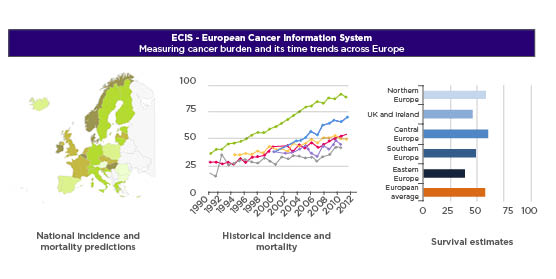Cancer is the second leading cause of mortality in European Union (EU) Member States,1 with more than 1.4 million deaths estimated for 2018 across the 28 EU countries.2 For more than 30 years since the first ‘Europe against cancer’ programme was launched, actions taken at the EU level3 have helped to extend and save lives. Evaluation of the implemented measures and their effectiveness is critically dependent on accurate and comparable data allowing derivation of cancer indicators (i.e., incidence, mortality, survival): reliable high-quality information helps co-ordinate and improve cancer prevention across the EU via the promotion of good practices. In support of this process, the Joint Research Centre (JRC), acting in its scientific role to the European Commission and in close collaboration with the Commission’s Directorate-General for Health and Food Safety (DG SANTE) as well as with major European stakeholders in the field, has been developing and is maintaining the European Cancer Information System (ECIS) as a comprehensive health and research infrastructure harmonising cancer registries’ data and producing meaningful information to facilitate the interpretation of the dynamics of cancer in Europe.
Data needed to quantify the cancer burden in a geographically-defined population are systematically collected by population-based cancer registries (CR), which are the information source for all reportable cancer cases in the specific area. Since 2012, in response to the call from the European Council to the Commission to act further in harmonising EU cancer registration, the JRC has taken an active role in supporting the activities and exploiting the data of the CR affiliated to the European Network of Cancer Registries (ENCR), currently including 178 individual registries across Europe (comprising non-EU countries).4 The contribution of the JRC consists not only in the harmonisation of CR data and registration processes, but also in the collection, validation, analysis, and dissemination of the cancer burden indicators computed from CR input data. The ECIS infrastructure has been developed by the JRC in recent years serving this purpose, consisting of several components to manage a central data repository and to
co-ordinate in an efficient and sustainable way the activities of data quality control, analysis,
and dissemination.
A key component of the system is the ECIS web application (Figure 1).5 This web-based module, launched in February 2018, was conceived and designed to provide information on and to visualise the cancer burden indicators. The application provides views across three main types of information: historical incidence and mortality indicators at registry level, national incidence and mortality predictions, and national survival estimates. It provides the means for comparing geographical patterns and temporal trends of incidence, mortality, and survival data of up to 58 different cancer sites. The database feeding the web application is dynamic, and is updated as new data become available. It currently hosts more than 34 million cancer cases submitted by approximately 150 European population-based CR in 34 European countries.

Figure 1: The three data modules of the ECIS web application.
Adapted from www.ecis.jrc.ec.europa.eu
Since the ECIS web application provides information on geographical patterns and temporal trends of cancer burden indicators at national and/or regional level, it constitutes an important tool for promoting awareness of the cancer burden dynamics confronting Europe. ECIS is a major step forward as an information source for the citizens, as well as in assisting political decision making and supporting epidemiological research.
Since the ECIS web application provides information on geographical patterns and temporal trends of cancer burden indicators at national and/or regional level, it constitutes an important tool for promoting awareness of the cancer burden dynamics confronting Europe. ECIS is a major step forward as an information source for the citizens, as well as in assisting political decision making and supporting epidemiological research.








